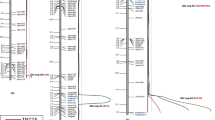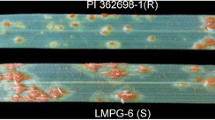Abstract
The prevalence of root disease after planting in cold spring soils has hindered the adoption of reduced or no-tillage cereal cropping systems in the Pacific Northwest. In particular, R. solani AG8, a necrotrophic root pathogen, can cause significant damage to wheat stands under these conditions. In previous efforts to find root rot resistance, a CIMMYT synthetic wheat line, SYN-172, was found to have little to no seedling stunting from disease and lower root disease scores. To identify trait-maker associations, a population consisting of 150 BC1F5 recombinant inbred lines from a cross of “Louise,” a typically susceptible Pacific Northwest (PNW) cultivar, and SYN-172 was created. A total of 689 polymorphic markers were used to identify trait-marker associations for seedling stunting in field green bridge and growth chamber environments. In total, five quantitative trait loci (QTL) were found on chromosome arms 1AL, 2AL, 5BL, 7DS, and 7DL. One QTL, on chromosome 2AL, was consistently detected in all four of the environments tested, and originated from SYN-172. A second QTL on 7DL, originating from the susceptible parent Louise, was found consistently in all three of the field environments, but not in soils artificially infested with R. solani AG8. These QTL have not been previously reported and will be useful root rot resistance genes when transferred into the PNW spring wheat germplasm.



Similar content being viewed by others
References
Babiker E, Hulbert S, Schroeder K, Paulitz T (2011) Optimum timing of preplant applications of glyphosate to manage Rhizoctonia root rot in barley. Plant Dis 95(3):304–310
Bailey D, Paveley N, Spink J, Lucas P, Gilligan C (2009) Epidemiological analysis of take-all decline in winter wheat. Phytopathology 99(7):861–868
Becker SR, Byrne PF, Reid SD, Bauerle WL, McKay JK, Haley SD (2016) Root traits contributing to drought tolerance of synthetic hexaploid wheat in a greenhouse study. Euphytica 207(1):213–224
Cook RJ (2001) Management of wheat and barley root diseases in modern farming systems. Australas Plant Pathol 30(2):119–126
Cook RJ, Schillinger WF, Christensen NW (2002) Rhizoctonia root rot and take-all of wheat in diverse direct-seed spring cropping systems. Can J Plant Pathol 24(3):349–358
Kidwell K, Shelton G, Demacon V, Burns J (2006) Registration of ‘Louise’ wheat. Crop Sci 46(3):1384
Lopes MS, Reynolds MP (2011) Drought adaptive traits and wide adaptation in elite lines derived from resynthesized hexaploid wheat. Crop Sci 51(4):1617–1626
Maccaferri M, Ratti C, Rubies-Autonell C, Vallega V, Demontis A, Stefanelli S et al (2011) Resistance to soil-borne cereal mosaic virus in durum wheat is controlled by a major QTL on chromosome arm 2BS and minor loci. Theor Appl Genet 123(4):527–544
Mahoney A, Babiker E, Paulitz T, See D, Okubara P, Hulbert S (2016) Characterizing and mapping resistance in synthetic-derived wheat to Rhizoctonia root rot in a green bridge environment. Phytopathology 106(10):1170–1176
Mazzola M, Smiley RW, Rovira AD, Cook RJ (1996) Characterization of Rhizoctonia isolates, disease occurrence and management in cereals in: Rhizoctonia species: taxonomy, molecular biology, ecology, pathology and disease control. Springer, Dordrecht, pp 259–267
Mujeeb-Kazi A, Hettel GP (1995) Utilizing wild grass biodiversity in wheat improvement: 15 years of wide cross research at CIMMYT. CIMMYT Res. Rep. No. 2. CIMMYT, Mexico D.F., pp 122–140
Nakedde T, Ibarra-Perez FJ, Mukankusi C, Waines JG, Kelly JD (2016) Mapping of QTL associated with Fusarium root rot resistance and root architecture traits in black beans. Euphytica 212(1):51–63
Okubara P, Schroeder K, Paulitz T (2008) Identification and quantification of Rhizoctonia solani and R. oryzae using real-time polymerase chain reaction. Phytopathology 98(7):837–847
Okubara PA, Steber CM, DeMacon VL, Walter NL, Paulitz TC, Kidwell KK (2009) EMS-treated hexaploid wheat genotype Scarlet has enhanced tolerance to the soilborne necrotrophic pathogens Rhizoctonia solani AG-8 and R. oryzae. Theor Appl Genet 119(2):293-303.
Paulitz TC (2006) Low input no-till cereal production in the Pacific Northwest of the US: the challenges of root diseases. Eur J Plant Pathol 115(3):271–281
Paulitz T, Schroeder K (2005) A new method for the quantification of Rhizoctonia solani and R. oryzae from soil. Plant Dis 89(7):767–772
Paulitz TC, Smiley RW, Cook RJ (2002) Insights into the prevalence and management of soilborne cereal pathogens under direct seeding in the Pacific Northwest, USA. Can J Plant Pathol 24(4):416–428
Paulitz T, Smith J, Kidwell K (2003) Virulence of Rhizoctonia oryzae on wheat and barley cultivars from the Pacific Northwest. Plant Dis 87(1):51–55
Poland JA, Brown PJ, Sorrells ME, Jannink J-L (2012) Development of high-density genetic maps for barley and wheat using a novel two-enzyme genotyping-by-sequencing approach. PLoS One 7(2):e32253
Schneebeli K, Mathesius U, Watt M (2015) Brachypodium distachyon is a pathosystem model for the study of the wheat disease rhizoctonia root rot. Plant Pathol 64(1):91–100
Schroeder K, Paulitz T (2008) Effect of inoculum density and soil tillage on the development and severity of Rhizoctonia root rot. Phytopathology 98(3):304–314
Schroeder K, Okubara P, Tambong J, Lévesque C, Paulitz T (2006) Identification and quantification of pathogenic Pythium spp. from soils in eastern Washington using real-time polymerase chain reaction. Phytopathology 96(6):637–647
Shannon L, Yandell B, Broman K (2013) Users guide for new BCsFt tools for R/qtl. Available at: http://cran.r-project.org/web/packages/qtl/ vignettes/bcsft.pdf. pp 1-20
Smiley RW, Collins HP, Rasmussen PE (1996) Diseases of wheat in long-term agronomic experiments at Pendleton, Oregon. Plant Dis 80(7):813–820
Thompson AL, Smiley RW, Garland-Campbell K (2015) Registration of the LouAu (Louise/IWA8608077) wheat recombinant inbred line mapping population. J Plant Regist 9(3):424–429
Thompson AL, Mahoney AK, Smiley RW, Paulitz TC, Hulbert S, Garland-Campbell K (2017) Resistance to multiple soil-borne pathogens of the Pacific Northwest, USA is colocated in a wheat recombinant inbred line population. G3: Genes, Genomes, Genetics 7(4):1109–1116
Voorrips R (2002) MapChart: software for the graphical presentation of linkage maps and QTLs. J Hered 93(1):77–78
Weller DM, Cook RJ, MacNish G, Bassett EN, Powelson RL, Petersen RR (1986) Rhizoctonia root rot of small grains favored by reduced tillage in the Pacific Northwest. Plant Dis 70:70–73
Acknowledgements
We thank the Washington Grain Commission for their support (grants 3061-4548 and 3061-5746), PPNS 0717, Department of Plant Pathology, College of Agriculture, Human and Natural Resource Sciences, Agricultural Research Center, Hatch Project Number WNP00663, Washington State University, Pullman 99164-6430.
Author information
Authors and Affiliations
Corresponding author
Rights and permissions
About this article
Cite this article
Mahoney, A.K., Babiker, E.M., See, D.R. et al. Analysis and mapping of Rhizoctonia root rot resistance traits from the synthetic wheat (Triticum aestivum L.) line SYN-172. Mol Breeding 37, 130 (2017). https://doi.org/10.1007/s11032-017-0730-9
Received:
Accepted:
Published:
DOI: https://doi.org/10.1007/s11032-017-0730-9




